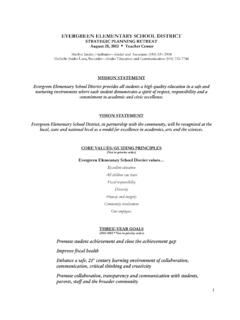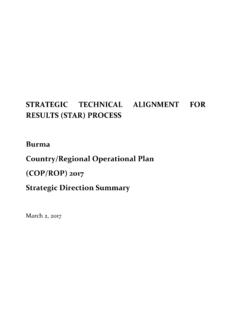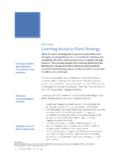Transcription of STRATEGIC PLAN Fiscal Years 2013-2016 - AIHFS
1 1 American Indian Health and Family Services of Southeastern Michigan, Inc. STRATEGIC plan Fiscal Years 2013 -2016 Honor the past, Heal the present, Create for the future 2 Table of Contents Mission and Vision .. 3 Values .. 4 Maps of Population and Service Area .. 5 Letter from the Executive Director and Chairman of the 7 Board of Directors .. 8 STRATEGIC Planning Process .. 9 Environmental Scan/Needs Analysis .. 11 STRATEGIC plan .. 15 Programs and Services at American Indian Health and Family Services .. 18 3 Mission and Vision Our Mission: Enhance the physical, spiritual, emotional, and mental wellbeing through culturally grounded health and family services that empower American Indian families, and other underserved population in SE MI.
2 Our Vision: AIHFS will be nationally recognized as a leading Urban Indian health and community center supporting healthy Native people, families, and communities. 4 Values The values of the organization are based on the seven teachings of the Grandfathers that were given by the Great Spirit to the Anishinaabeg who are represented generally by the Chippewa, Ottawa, and Potawatomi. Although these groups are native to the Great Lakes area, and though spirituality among American Indians is as varied as the geography they inhabit, we believe the teachings are as fundamental and universal as the human condition, wherever it exists. To cherish knowledge and experience in the physical world, and use such knowledge of traditional and modern medicine to heal body and soul.
3 Examples include: Offering western medicine, sweat lodges, ceremonies To share resources to help our brothers and sisters Examples include: Providing resources on-site, through use of social media, and events To have care and concern for all, regardless of status in life. Examples include: Providing services to all that visit AIHFS To confront the most difficult issues presented to the organization with bravery. Examples include: Dealing with budget cuts, political environment To conduct every activity with a pure heart and in a straightforward manner Examples include: Being accountable and transparent with finances and policies To think about family, fellow human beings, and community before one thinks of themselves. Examples include: Dedicated staff, interns, and volunteers, interns To be aware of all the teachings and consistently ensure Minobinwaaszwin- a Good Life.
4 Examples include: Smudging and give thanks before meetings and gatherings5 Maps of Population and Service Area American Indian Health and Family Services is a non-profit health and human services agency located in Detroit, Michigan. We serve American Indian children and families throughout southeastern Michigan with an emphasis on Wayne, Oakland and Macomb counties. Our organization is funded through a combination of public and private sources. The following map shows our service area: 6 According to the 2010 Census there are a total number of 47,955 American Indian/Alaska Native (Alone or in Combination with Other Races) residing in our 7 county service area. 7 Letter from the Executive Director and Chairman of the Board There have been a lot of changes in healthcare in the last couple Years .
5 In fact there have been a lot of changes all around us. Some of these changes are positive and some of them are forcing us to think in new ways. While we can not always predict the future, we have created this STRATEGIC plan to help us navigate these changes, take advantage of opportunities, and point us to the future. This STRATEGIC plan involved the hard work of our Board of Directors, Staff, and community members including our youth. We also had a great facilitator (Darryl Tonemah) who guided us through part of this process. To everyone that contributed to this process, I want to say thank you for your commitment to AIHFS and for your hard work. The STRATEGIC plan describes where we want to go and how we expect to get there. While it is important to have this direction and a formal written plan , it does not mean anything unless we use it.
6 Think of it as a journey. We have the map and we have a team to complete this journey. In addition, this STRATEGIC plan includes measurable goals with set expectations that will continue to be monitored throughout the next three Years . This will give us the basis for assessing whether or not we are reaching our goals and objectives and allow us to re-evaluate our processes and activities to ensure that we are striving for the desired outcome. Sincerely, Ashley Tuomi John Lemire Executive Director Chairman of the Board 8 Board of Directors Chairperson: John Lemire (Chippewa/Grand Portage Band) Vice-Chair: Marilyn A. Roubidoux (Iowa of Kansas/Nebraska) Treasurer: Joanne Sobeck (Chippewa/Sault Tribe) Secretary: Marcia Ryan (Non-Native) Members at Large: Conner Sandefur (Chickasaw Nation, OK) Katherine McCloskey (Haliwa-Saponi/Cherokee) Sioux Trujiilo (Navajo) Karen Marshall (Self-identified) Stephen James (Eastern Band Cherokee/Mohawk from Kahnawake) 9 STRATEGIC Planning Process The STRATEGIC planning process included input from our community, staff, leadership, and our Board of Directors.
7 We held sessions with our Community Advisory Board, Youth Advisory Board, Staff, and Board of Directors that included a distinctive competencies exercise. We also conducted a joint session with Community Members, Staff, and the Board of Directors on STRATEGIC Planning where we looked at our current Mission, Vision, and Values as well as conducting a SWOT analysis. All of these activities led us to our STRATEGIC plan for FY 2013 -2016 The first step was to do a distinctive competenecies exercise which was done at a Community Advisory Council Meeting, Youth Advisory Council Meeting, Staff Meeting, and with the Board of Directors. From this exercise we were able to look at the services and characteristics that make AIHFS unique as well as what each of the groups viewed as a priority.
8 Community Advisory Council Youth Advisory Staff Board of Directors 1. Spirituality and Traditional Practice 2. Community Gatherings/Group Activities 3. Leadership/Dedicated Staff 1. Youth Activities 2. Traditional Services/Teachings/ Part of Identity/Culture 3. Working with Elders/Community Leaders 1. Transportation Services 2. Strong Staff Involvement 3. Integration of Culture & Western Medicine 1. Cultural & Traditional Services 2. Dedicated Staff, Board, & Volunteers 3. Medical & Behavioral Services The distintictive competencies exercise was a great way to identify the strengths of AIHFS . In order to complete the Strength, Weakeness, Opportunities,Threats (SWOT) analysis, a survey was distributed through Survey Monkey. The link was sent to staff, board members, and community advisory council members.
9 Some of the strengths that were identified included. of respondents felt that AIHFS was successful in meeting the mission, felt that AIHFS strived to consistenly meet the vision of AIHFS , and felt that we adhere to our values. There were also some weakensses that were identified. These weakneses include lack of space, wait times for appointments and in the office, a lack of services including after-hour call service, and speciality care. 10 There were many opportunitunites that were presented including improving communication with the community and overall customer service. There was also an opportunity for expanding services that was presented. These services included more expansive mental health services (psychologist/psychiatrist), women s health, dental, pain management,case management, expansion of transportation services and the ability to do forensic exams for sexual assault.
10 Participants identified emerging trends as integrated care, the Affordable Care Act, and health/fitness. There was also an opportunity to expand our reach to communities outside of the Detroit Metropolitan area. Although we serve a 7 county area they felt that there was some concentrated efforts made in some of these areas. Possible threats included other clinics and organizations that provide some of the same services that we provide. These include both Native and non-native organizations. There were also some financial threats that included the fragil state and unreliability of grant funding, cuts in funding including Sequestration and government shutdowns, funding restrictions, and the Affordable Care Act. Other threats included issues with space and the condition of the building including needly to constantly make costly repairs and running out of space.





